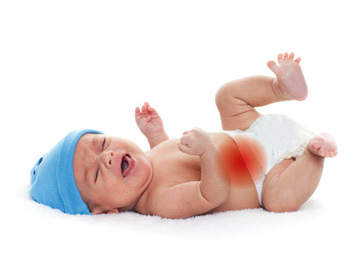Gastroenteritis is caused by irritation and inflammation of the gastrointestinal tract, which often results in diarrhoea, abdominal cramps, nausea, vomiting, and fever. This stomach and intestinal infection can be contagious, and can spread through contact with an infected person, unhygienic practices, and through contaminated objects, food or water. Anyone can contract gastroenteritis. However, it is more common among infants and children under the age of 5.
What causes gastroenteritis?
Gastroenteritis is caused by infection from different types of bacteria and viruses. These infectious agents can come from outside a person’s body, or result from an internal condition. Among the most common types of bacteria causing this infection are:
- Escherichia coli (E.coli) – causes food poisoning, dysentery, traveler’s diarrhoea or colitis.
- Salmonella – can cause typhoid fever or non-typhoidal food-poisoning.
- Shigella – can cause dysentery (inflammation of the large intestine causing bloody diarrhea).
- Campylobacter – from undercooked meat and unpasteurised milk.
Viruses such as Rotavirus, Norovirus, and Adenovirus account for 30 – 40% of gastroenteritis in children. They spread through close contact in daycares and schools. Each of these organisms causes a person to develop slightly different symptoms, but they all share one similarity: acute diarrhoea leading to dehydration.
According to the World Health Organisation, diarrhoeal disease is the second leading cause of death worldwide in children under the age of five and is responsible for killing 1.5 million children every year. Unlike bacterial infections, which are treatable with antibiotics, viral infections do not respond to antibiotics and add to the global statistics of child fatalities, especially in under-developed countries.
Know your viruses
It is important to know which infectious viruses are causing your child to run to the washroom every few hours so that immediate action can be taken to control and prevent the spread of this infection.
- Rotavirus
- Adenovirus
- Norovirus
Rotavirus, which resembles a wheel when looked under an electron microscope, is the most common and potentially lethal virus that primarily infects infants and young children. Symptoms such as fever, nausea, vomiting and watery diarrhoea will appear two days after exposure to this virus, and the symptoms may last up to eight days.
The virus spreads through the faecal-oral route. The germs from this virus survive for quite a long time on surfaces such as toys or furniture.
Most children by the age of 5 would have been infected by rotavirus, and the first infection is usually the worst. This is because once a child is exposed to this virus, subsequent exposure to it will have less severe effects as immunity against the virus develops.
Rotavirus vaccines have played a major role in preventing the spread of this virus in young children. The US Centers for Disease Control and Prevention (CDC) reports that while this viral disease is still a significant public health problem globally, there has been a clear reduction in hospitalisations and deaths of young children following the introduction of the vaccine.
Dehydration as a result of diarrhoea can be treated through oral rehydration. This means giving your child more fluids in the form of milk or oral rehydrating salt solutions to drink. Children who have been immunised and breastfed also stand a better chance against the rotavirus.
Adenovirus is mainly linked to respiratory illnesses; however it also causes gastroenteritis, conjunctivitis, and bladder infection. Symptoms from this viral infection range from the common cold to pneumonia and bronchitis. Infants, young children and those with compromised immune systems are more susceptible to the effects of this infection.
Similar to the Rotavirus, Adenovirus is transmitted through the faecal-oral route, and direct contact with contaminated objects and water. Specifically, it is type 40 and 41 of the Adenovirus that causes gastroenteritis, both in children and adults. Infection from this virus is usually mild and does not require active therapy, only treatment of its symptoms or complications. There is also no specific vaccine or drug to treat this type of viral infection.
Formerly known as the Norwalk-like virus or NLV, Norovirus belongs to a family of gastroenteritis-causing viruses. Infection from this virus normally occurs in closed or crowded environments, such as hospitals, market places or nursing homes. This viral infection occurs in all age groups, but is more common in adults. Symptoms of diarrhoea, abdominal pains and vomiting begin to develop 24 – 48 hours after exposure and could last up to a few days.
Similar to Rotavirus and Adenovirus, infection from Norovirus is mild and does not require therapy, only treatment of its symptoms or complications. There is also no specific vaccine or drug to treat this type of viral infection. However, this type of viral infection can occur if a person’s immune system is not strong enough to fight it.
Preventing and controlling the spread: The self-care method
In order to reduce the chances of your child contracting gastroenteritis, always practise good hygiene. Hands must be well-washed after using the toilet, and before eating or touching food. Clean and disinfect contaminated surfaces after an episode of vomiting or diarrhoea. Wash all laundry thoroughly. The best prevention method is by vaccinating against the most common viral cause – Rotavirus – even though it cannot prevent infection by the other organisms mentioned above.
However, if your child has already contracted viral gastroenteritis, it is crucial to keep your child well-hydrated. A variety of oral rehydration solutions are available in Malaysia. Avoid giving your child fluids like water or apple juice. Water does not replace lost electrolytes and apple juice could worsen the diarrhoea. Continue to give milk, especially if it is breast milk. Seek immediate medical attention if your child cannot take fluids by mouth or in severe cases of dehydration.






Comments